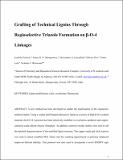Grafting of technical lignins through regioselective triazole formation on β-O-4 linkages
Date
13/09/2017Author
Grant ID
EP/K00445X/1
EP/J018139/1
EP/J018139/1
EP/K00445X/1
EP/L016419/1
Metadata
Show full item recordAbstract
A new method has been developed to enable the modification of the organosolv technical lignin. Using a walnut shell butanol alkoxasolv lignin as a source of high β-O-4 content material, the β-O-4 γ-position has been selectively modified via tosylation, azidation and copper-catalyzed azide-alkyne triazole formation . In addition, extensive model studies were used to aid the detailed characterization of the modified lignin structure. The copper catalyzed click reaction was used to attach modified PEG chains and the resulting lignin-based co-polymer displayed improved thermal stability. This protocol was also used to incorporate a novel BODIPY-type fluorophore, generating a fluorescent lignin. Copper catalytic loadings were effective as low as 0.3 weight% and were found to catalyze the cycloaddition efficiently. This efficient and generic approach to preparing lignin-derived polymers is relevant to the core societal challenge of improving biorefinery efficiency.
Citation
Panovic , I , Montgomery , J R D , Lancefield , C S , Puri , D , Lebl , T & Westwood , N J 2017 , ' Grafting of technical lignins through regioselective triazole formation on β-O-4 linkages ' , ACS Sustainable Chemistry & Engineering , vol. 5 , no. 11 , pp. 16040-10648 . https://doi.org/10.1021/acssuschemeng.7b02575
Publication
ACS Sustainable Chemistry & Engineering
Status
Peer reviewed
ISSN
2168-0485Type
Journal article
Description
This work was supported by EPSRC (grants EP/J018139/1, EP/K00445X/1 (NJW), the EPSRC funded CRITICAT Centre for Doctoral Training (Ph.D. studentship to IP; EP/L016419/1) and EPSRC Doctoral Prize Fellowship (CSL)Collections
Items in the St Andrews Research Repository are protected by copyright, with all rights reserved, unless otherwise indicated.
Related items
Showing items related by title, author, creator and subject.
-
Unusual intermolecular “through-space” J couplings in P–Se heterocycles
Sanz Camacho, Paula; Athukorala Arachchige, Kasun Sankalpa; Slawin, Alexandra Martha Zoya; Green, Timothy F.G.; Yates, Jonathan R.; Dawson, Daniel McLean; Woollins, J Derek; Ashbrook, Sharon Elizabeth (2015-05-20) - Journal articleSolid-state NMR spectra of new P–Se heterocycles based on peri-substituted naphthalene motifs show the presence of unusual J couplings between Se and P. These couplings are between atoms in adjacent molecules and occur ... -
Controlling the electromagnetic proximity effect by tuning the mixing between superconducting and ferromagnetic order
Stewart, R.; Flokstra, M. G.; Rogers, M.; Satchell, N.; Burnell, G.; Miller, D.; Luetkens, H.; Prokscha, T.; Suter, A.; Morenzoni, E.; Lee, S. L. (2019-07-12) - Journal articleWe present low-energy muon-spin rotation measurements on Cu/Nb/AlOx/Co thin films that probe the newly described electromagnetic (EM) proximity effect. By varying the thickness of the insulating AlOx layer we control the ... -
Switching on electrocatalytic activity in solid oxide cells
Myung, Jaeha; Neagu, Dragos; Miller, David N.; Irvine, John T. S. (2016-09-22) - Journal articleSolid oxide cells (SOCs) can operate with high efficiency in two ways—as fuel cells, oxidizing a fuel to produce electricity, and as electrolysis cells, electrolysing water to produce hydrogen and oxygen gases. Ideally, ...

